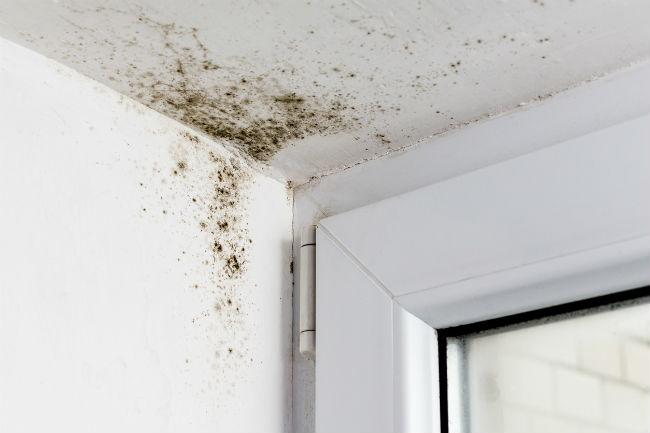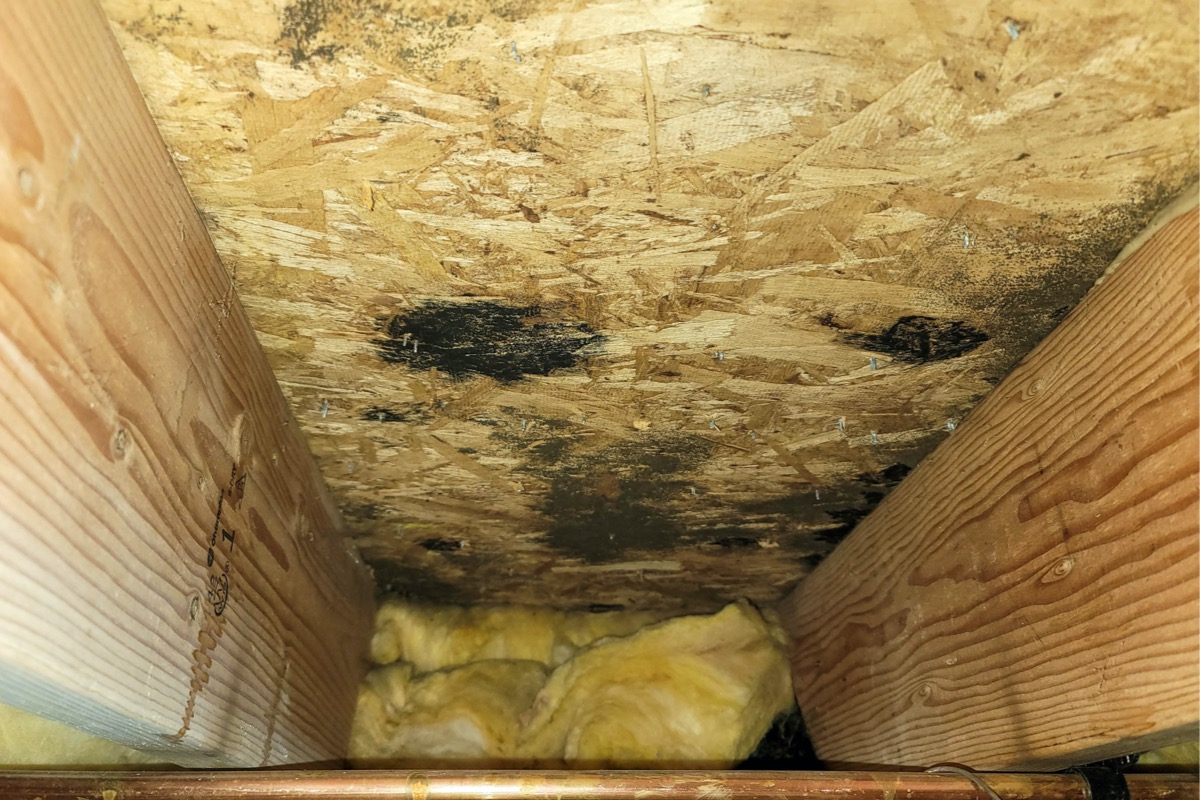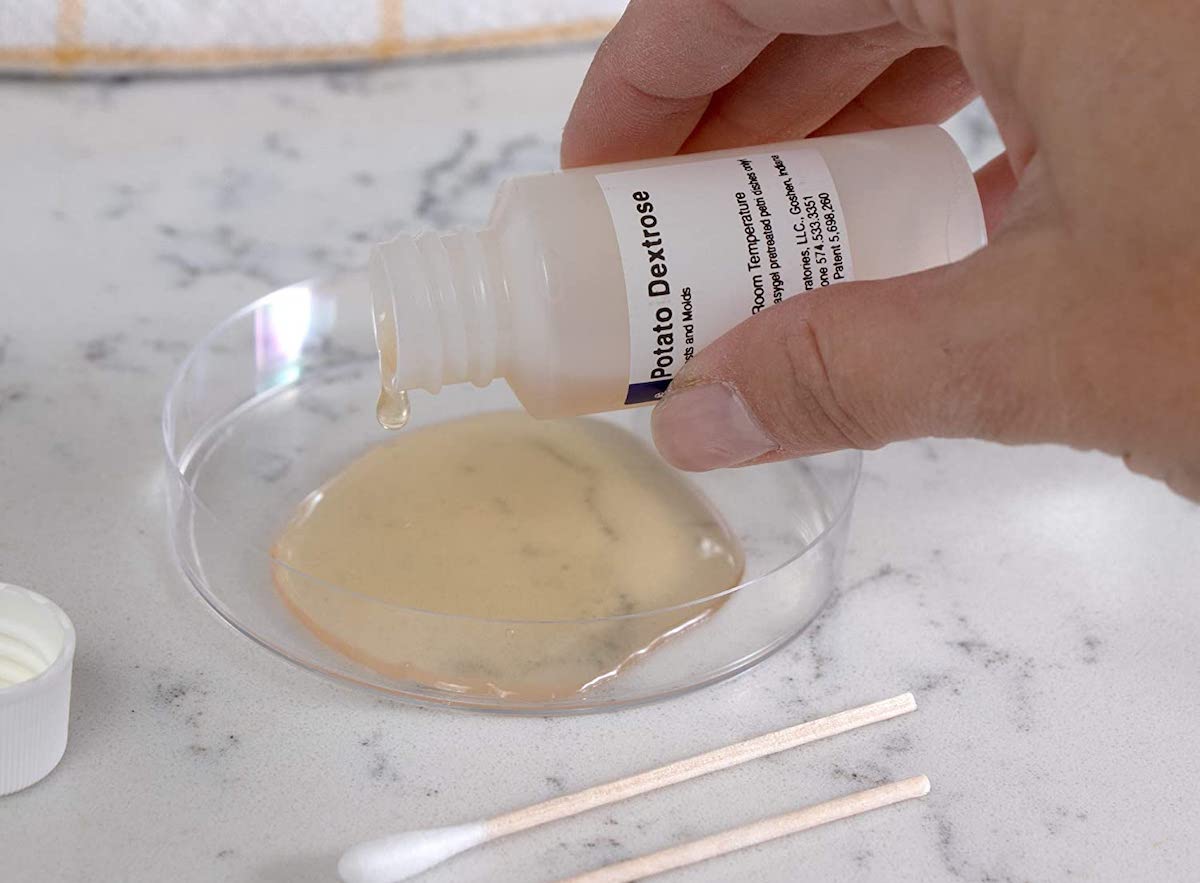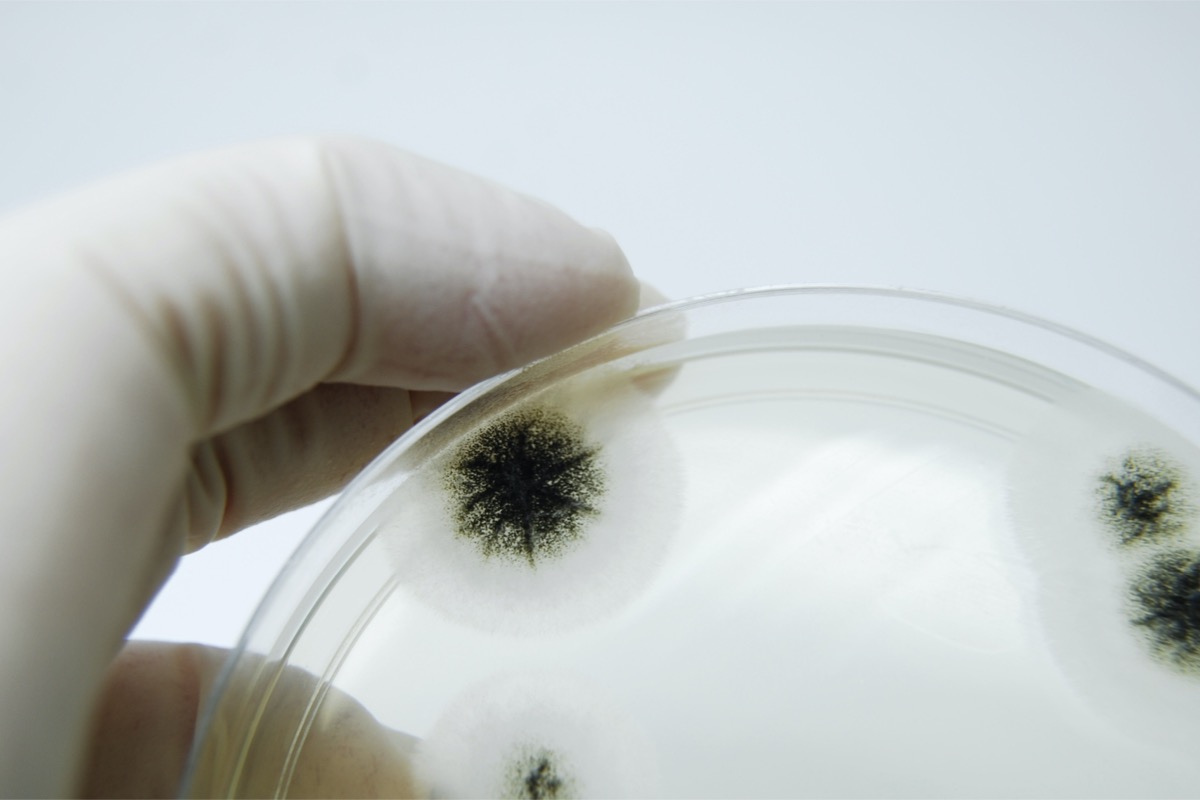

We may earn revenue from the products available on this page and participate in affiliate programs. Learn More ›
Project Overview
- Mold is primarily found in high-moisture areas like kitchens and bathrooms, and anywhere that has experienced flooding or leaks.
- Homeowners can test for mold using a DIY kit but will need to send the results to a lab to determine the type of mold present.
- Left unattended, mold can become a health hazard for the residents of a home, so it’s vital to address the problem right away.
- A professional mold remediation company can get rid of the mold quickly, allowing homeowners to enjoy their space worry-free
Editor’s Note: If you are experiencing the symptoms of mold exposure, which includes coughing, sneezing, congestion, and shortness of breath per the CDC, it’s best to consult a medical professional.
Damp rooms, such as a bathroom, are prime breeding grounds for mold and mildew. Some of the most common signs of a mold problem include discolored spots on walls and floors, the development of respiratory problems in residents, and noticeable humidity. If a homeowner spots any of these signs, or otherwise suspects that there’s mold in their home, they can learn how to test for mold to confirm their suspicions
Testing can as simple as purchasing one of the best mold test kits and collecting samples in strategic locations. If the results could come back negative, the musty smell is likely a temporary, easily remedied issue. If the results are positive for mold spores, the best course of action is for the homeower to send the test to a lab to determine what type of mold it is and how to effectively treat it.
The Most Common Types of Household Mold
While there are thousands of species of mold in existence, most homeowners are concerned about Stachybotrys chartarum, commonly known as “toxic mold” or “black mold.” This species of mold is actually quite rare, but it’s one of a number of molds that produce a high level of mycotoxins (dangerous mold-based chemicals) that can create a hazardous home environment. That said, any species of mold can become a health risk if it’s allowed to grow out of control.
“All molds have the potential to cause reactions in those individuals who are susceptible to mold [such as those who have allergies or respiratory disorders],” says Karen Peissinger, industrial hygiene generalist at the University at Buffalo. “Also, that susceptibility can range from no reaction to a severe reaction, just like with dog and cat allergies. Thus, cleaning up any mold using proper methods is important.”
To be on the safe side, homeowners will want to have mold growth identified, treated, and removed quickly. Below are some of the more common types of mold that can be found in a home.
- Mucormycetes: Mucormycetes fungi, including Cunninghamella bertholletiae, Rhizomucor species, and Syncephalastrum species, are most commonly found in the soil during the summer and fall. It is difficult to avoid these molds completely, but they are generally harmless to most individuals.
- Alternaria: Alternaria alternata is an allergy-causing mold that is prevalent in the environment and may be brought into a home from the outdoors. It is dark in color and has a velvety texture. Once inside, it can spread quickly through the home, so prompt removal using a cleanser with bleach is important.
- Aspergillus: While most prevalent in the air, Aspergillus can also be found in soil, compost piles, stored grains, and decaying plants. Once brought inside a home, it can grow and spread over surfaces such as clothing, leather, or building materials, particularly in moist areas.
Where to Look for Signs of Mold in Your Home
In many cases, the location of the mold can provide clues as to its cause. For example, mold on a window sill may be an indication that the window is not sealed properly, leading to leaks. There are several common spots for mold to grow undetected, offering a starting location for homeowners to test for mold.
- Behind the refrigerator
- Under stacks of newspapers or cardboard
- Behind the drywall in wall stud spaces that contain plumbing lines
- Under sinks
- Behind the wallboard around leaking windows
- In ventilation ducts
- Under carpeting that was wet at one time (flooding, carpet cleaning)
- On the back side of acoustic ceiling tiles (if roof leaked)
- Behind any drywall that has been affected by a home flood

How to Test for Mold Using a Test Kit
Home mold test kits are widely available from home improvement stores and from online retailers, but not all test kits are the same. Some are designed to only determine whether mold is present on surfaces. If a homeowner wants to test for mold spores in the air, they’ll need to purchase a viable mold detection kit such as Seeml Labs’ Mold Inspector in a Box; most quality mold tests cost between $10 and $40. The entire testing process will take a few days. If the mold test comes back positive, the homeowner can send the testing materials to a lab to determine what type of mold is present, which can have an additional cost.
Homeowners will want to note that the Environmental Protection Agency (EPA) does not endorse any brand of home mold test kit. Rather, it recommends that homeowners pay for professional mold inspection costs if they are concerned about the presence of mold. “If it is a large amount of mold, then the homeowner should contract with experienced assessment and remediation professionals. Ideally these professionals would hold valid credentials for mold assessment and mold remediation,” says Peissinger. “Also, some states have their own mold certification or licensing program. One more thing, to avoid conflict of interest, the mold assessor should be independent of the mold remediation company.”
Of course, if the symptoms are visible and dire, it’s best for a homeowner to call in the pros to test for mold and remove colonies from their home right away. Homeowners can search for “mold testing near me” to find a professional in their area who can detect and remove mold from the home.
Tools & Materials
Bobvila.com may earn a commission from purchases made through these links.
Before You Begin…
Mold requires moisture to grow, which is why it’s most commonly found in damp, humid areas. Plumbing leaks, for example, often trigger mold growth and need to be repaired as soon as they are discovered. If there is visible mold anywhere in the home, it won’t be necessary to test for mold before cleaning it or hiring one of the best mold removal companies. According to Peissinger, “Mold testing is not necessary in the vast majority of cases. If mold is visible, it should be cleaned up properly.” She recommends consulting EPA guidelines to find out how to remove mold safely.
What about mold growth that can’t be seen? If a homeowner notices a musty smell but no visible signs of mold (a black, white, or brownish coating), they may have mold growing where they can’t see it. In this case, homeowners will want to take the following steps to determine if household mold is present, while being sure to take the proper precautions to avoid inhaling or coming into contact with mold spores.
Tips for Getting Rid of Mold
- It is possible to kill mold with a few common household products such as vinegar or a mixture of baking soda and water.
- For mold growth that exceeds 10 square feet, the EPA recommends professional cleanup. Professional mold remediation costs $2,254 on average.
- After removal, the best way to prevent mold and mildew is to reduce the home’s humidity and eliminate any water leaks.
Safety Considerations
- Anyone can suffer from the effects of exposure to mold spores, but the risk of health problems increases for those with known allergies, compromised immune systems, and respiratory disorders—even if the home has been allergy-proofed.
- Some symptoms and signs of mold exposure can include coughing and wheezing, shortness of breath, frequent sneezing, irritated or itchy skin, watery eyes, running nose, chronic headaches, skin rashes, chronic fatigue, memory loss, and diminished ability to concentrate.
- When handling or cleaning mold, it’s a good idea to wear gloves, goggles, and a mask for protection.
STEP 1: Close off the space.
Before starting the mold test, homeowners will want to close the windows and doors in the room they’ll be testing 24 hours prior to testing. This allows potential mold spores to congregate without being disturbed by drafts.
STEP 2: Set up the test kit.
The first step in testing is to remove the contents of the kit from its packaging. Typically, homeowners will find at least a shallow plastic or glass petri dish with a lid and a label. The inside of the petri dish has been treated with a substance known as a “microbial culture” that promotes the growth of mold spores. This should help the homeowner collect an adequate sample when testing for mold in the amount of time recommended by the manufacturer.

STEP 3: Leave the petri dish alone for a few days.
Next, homeowners will need to remove the lid from the petri dish and place the dish (open end upward) on a flat surface at about table height.
They’ll want to leave the petri dish untouched for about 48 hours. This time may vary slightly depending on the manufacturer’s instructions. During this time, homeowners will need to restrict traffic in the room to keep from disturbing the air. Homeowners can cover the doorway with a strip of painter’s tape if needed as a reminder to household members and guests that this area is temporarily off limits.
STEP 4: Seal the petri dish and stow it in a dark space.
Once the waiting time has passed, the homeowner will want to place the lid back on the petri dish and put a layer of tape around the seam where the lid meets the dish. Either transparent tape or electrical tape works well, but homeowners will want to avoid using a tape that’s difficult to remove, such as duct tape.
The homeowner will want to write today’s date on the label enclosed in the kit, and affix the label to the bottom of the petri dish. Then, they’ll need to place the taped petri dish in a dark spot, such as a dresser drawer or on a closet shelf.
STEP 5: Observe whether mold appears in the dish.
After 2 days have passed, the homeowner can check the petri dish for signs of mold growth. If mold is present, it will look similar to the mold they’d find growing on old food in the fridge.
- If the petri dish shows no signs of mold, the homeowner will want to return it to the dark spot and check it again daily. If the test turns up nothing after a total of 5 days (from the date on the label), they can throw the dish in the trash—the kit did not detect mold in the room.
- If mold is present in the dish, the homeowner can send the petri dish to the lab recommended by the manufacturer to determine the type of mold and the course of treatment. Many kits include an envelope for mailing, and the homeowner will also have to send payment for the analysis.

STEP 6: Consider additional tests as you wait for professional results.
Homeowners will want to allow 3 to 8 weeks to receive the results. Meanwhile, they may wish to continue testing for mold throughout the house. While a variable mold test can tell a homeowner if mold spores are present in a specific room, they’ll need to use additional kits if they want to test other rooms in the house. It may be worthwhile for a homeowner to look into who to call for a mold inspection and hire a professional if they suspect that the problem is extensive.
Since there is a wide range of potential health problems associated with mold, it is important for homeowners to take steps to detect mold in their home quickly and remove it promptly. Homeowners can follow the steps outlined above for how to test for mold to help them and others in the home breathe more easily. Homeowners can also consider investing in one of the best air quality monitors to provide additional reassurance that the air in the home is free of mold and other harmful pollutants.
FAQs
Because of the complexities and importance of learning how to accurately test for mold, it is understandable if homeowners have a few remaining questions. They can consult the FAQs below to learn more about mold inspection and testing.
While a homeowner may hear the terms “mold” and “mildew” used interchangeably, there are some key differences between these two organisms. While mildew is always flat or powdery in appearance with a white or gray color, mold is often raised, fuzzy, or slimy and can be different colors such as black, green, blue, or red.
Another key difference is that mold can burrow beneath the surface, while mildew is a surface fungi that is easier to spot. Mold also poses greater health risks than mildew. In addition to causing respiratory problems, like mildew, mold can also have a negative impact on the nervous system.
Black mold looks like a black stain. It is most often found in areas of higher moisture, particularly in those that have been cleaned after flooding. One of the signs of black mold is a circular growth pattern. Homeowners will want to look for round patches growing together; some may be smaller than an inch, with others being much larger. They can use a black mold test or schedule an inspection to verify if black mold is present.
Mildew is typically gray or white in color; it is a surface mold that stays flat as it grows. Mildew can also have a powdery consistency.
While there are some tests designed to identify mold exposure, they are not 100 percent reliable. However, a homeowner’s primary care physician may be able to assess their symptoms and perform blood tests or skin-prick tests to learn more about their sensitivity to mold.
Removing mold on the walls is important, but homeowners also need to know how to detect mold in walls to ensure that the issue is fully remedied. Mold test kits detect mold in the air, so if the mold spores inside the wall are getting into the air, they will be detected. Otherwise, the test kit may not find mold growing inside the walls.
